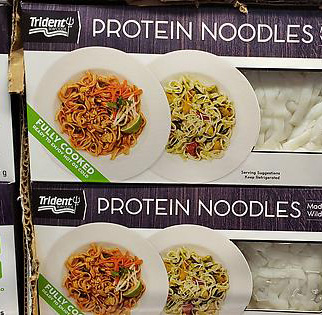Gluten-Free Noodles – Made from Fish? Believe it!
 The featured ingredient in the new gluten-free “protein noodles” stocked at Costco might surprise you: It’s pollock, the unassuming whitefish caught by the millions in the Bering Sea, off Alaska’s coast.
The featured ingredient in the new gluten-free “protein noodles” stocked at Costco might surprise you: It’s pollock, the unassuming whitefish caught by the millions in the Bering Sea, off Alaska’s coast.
- Nat Herz, Alaska’s Energy Desk 1
Trident Seafoods, one of the country’s largest seafood companies, is betting that Americans’ enthusiasm for protein means they’re ready for noodles made from fish.
And while skeptics have, in the past, dismissed pollock as a “trash fish,” the new noodles fit into a broader seafood industry push to brand pollock as a healthy, whole food worth paying for — to make pollock “sexy,” as an official with another company once put it.
“It’s been the Pabst Blue Ribbon to the microbrew,” said John Salle, a Trident executive who worked on the new noodles’ development. “We’re kind of taking it upon ourselves to really go out and extoll the virtues of wild Alaska pollock.”
Alaska’s fishing industry is better known for its annual summer harvest of salmon, with bright-red fillets shipped around the country. But fishermen catch Bering Sea pollock in far greater volumes — more than 2 billion pounds per year — using huge nets that stretch a quarter-mile long. Some boats actually process the catch in on-board factories, packing boxes full of frozen fillets and fish paste that are loaded into shipping containers at the dock.
Seafood companies have historically processed pollock into high-volume, lower-value products like fish sticks and fish fillets, as well as surimi — the minced fish used in fake crab. And much of the market for pollock is in Europe and Japan.
But in the past few years, companies have been marketing pollock in new ways in America, as a fish with its own identity that’s a fresh and healthy alternative to meat. Trident is introducing products like whole pollock, with the fish head still on, as well as boneless, skin-on fillets, Salle said.
“There’s definitely a renewed attention on pollock and its value,” said Dan Lesh, a Juneau-based senior analyst at McDowell Group, a research firm that works with the fishing industry. “There’s a widespread recognition that it’s a really high-quality protein and there’s a lot of value there to provide the world — and we just need to figure out how to market it and what people want to eat.”
The noodles are part of that push. They’re still processed — a Trident plant in Minnesota makes them out of surimi. But they only have eight ingredients, with 10 grams of protein in each serving.
And by going into noodles, Trident says it’s targeting a new group of consumers, rather than competing with its existing seafood products.
- “We saw an opportunity here not to position this as another imitation product, but to create a new category,” Salle said. “This is all incremental.”
The noodles are available at some Costco stores, though not yet in Alaska. For an Alaska Public Media taste test, a Trident official flew a package, with an ice pack, up from Seattle.
The noodles can be prepared hot or cold. For the test, Anchorage food writer Julia O’Malley cooked them in ramen, with steamed vegetables.
- She and others who have sampled them described the noodles as neutral, not fishy. And filling: “There’s, like, a caloric sort of density to them,” O’Malley said.
- They were heavy for ramen but would work well in other Asian dishes, like stir fries, she added — particularly if you want a low-carb option.
- “Is this noodle better than a rice noodle? No. What they offer that a rice noodle doesn’t is protein,” she said. “It comes down to what people want.”
Alaska’s Energy Desk is a public media collaboration focused on energy and the environment with partners KTOO in Juneau, Alaska Public Media in Anchorage, KUCB in Unalaska, Fairbanks Daily News-Miner in Fairbanks, KBRW in Utqiagvik and KYUK in Bethel.













